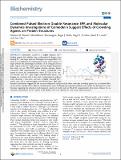Files in this item
Combined pulsed electron double resonance EPR and molecular dynamics investigations of calmodulin suggest effects of crowding agents on protein structures
Item metadata
| dc.contributor.author | Stewart, Andrew | |
| dc.contributor.author | Shanmugam, Muralidharan | |
| dc.contributor.author | Kutta, Roger | |
| dc.contributor.author | Scrutton, Nigel | |
| dc.contributor.author | Lovett, Janet Eleanor | |
| dc.contributor.author | Hay, Sam | |
| dc.date.accessioned | 2022-11-23T10:30:02Z | |
| dc.date.available | 2022-11-23T10:30:02Z | |
| dc.date.issued | 2022-09-06 | |
| dc.identifier | 280812865 | |
| dc.identifier | a1fbfb0b-2c61-4e01-ae92-7238c38f61d6 | |
| dc.identifier | 85136713859 | |
| dc.identifier | 000844106600001 | |
| dc.identifier.citation | Stewart , A , Shanmugam , M , Kutta , R , Scrutton , N , Lovett , J E & Hay , S 2022 , ' Combined pulsed electron double resonance EPR and molecular dynamics investigations of calmodulin suggest effects of crowding agents on protein structures ' , Biochemistry , vol. 61 , no. 17 , pp. 1735–1742 . https://doi.org/10.1021/acs.biochem.2c00099 | en |
| dc.identifier.issn | 0006-2960 | |
| dc.identifier.other | RIS: urn:01308CDB935423A86AA0ACA3FE7EC302 | |
| dc.identifier.other | ORCID: /0000-0002-3561-450X/work/124079068 | |
| dc.identifier.uri | https://hdl.handle.net/10023/26468 | |
| dc.description | A.M.S. received Early Stage Research Funding from the European Union’s Seventh Framework Programme FP-7-PEOPLE-2013-ITN through the “MAGnetic Innovation in Catalysis” (MAGIC) Initial Training Network (grant agreement no. 606831). Part of this work was also supported by BBSRC grant: BB/M007065/1. J.L. thanks the Royal Society for a University Research Fellowship, the Carnegie Trust (RIG007510), and the Wellcome Trust for a Multi-User Equipment grant (099149/Z/12/Z). | en |
| dc.description.abstract | Calmodulin (CaM) is a highly dynamic Ca2+-binding protein that exhibits large conformational changes upon binding Ca2+ and target proteins. Although it is accepted that CaM exists in an equilibrium of conformational states in the absence of target protein, the physiological relevance of an elongated helical linker region in the Ca2+-replete form has been highly debated. In this study, we use PELDOR (pulsed electron–electron double resonance) EPR measurements of a doubly spin-labeled CaM variant to assess the conformational states of CaM in the apo-, Ca2+-bound, and Ca2+ plus target peptide-bound states. Our findings are consistent with a three-state conformational model of CaM, showing a semi-open apo-state, a highly extended Ca2+-replete state, and a compact target protein-bound state. Molecular dynamics simulations suggest that the presence of glycerol, and potentially other molecular crowding agents, has a profound effect on the relative stability of the different conformational states. Differing experimental conditions may explain the discrepancies in the literature regarding the observed conformational state(s) of CaM, and our PELDOR measurements show good evidence for an extended conformation of Ca2+-replete CaM similar to the one observed in early X-ray crystal structures. | |
| dc.format.extent | 8 | |
| dc.format.extent | 2616245 | |
| dc.language.iso | eng | |
| dc.relation.ispartof | Biochemistry | en |
| dc.subject | QD Chemistry | en |
| dc.subject | QH301 Biology | en |
| dc.subject | DAS | en |
| dc.subject.lcc | QD | en |
| dc.subject.lcc | QH301 | en |
| dc.title | Combined pulsed electron double resonance EPR and molecular dynamics investigations of calmodulin suggest effects of crowding agents on protein structures | en |
| dc.type | Journal article | en |
| dc.contributor.sponsor | The Royal Society | en |
| dc.contributor.sponsor | The Wellcome Trust | en |
| dc.contributor.institution | University of St Andrews. Biomedical Sciences Research Complex | en |
| dc.contributor.institution | University of St Andrews. School of Physics and Astronomy | en |
| dc.identifier.doi | 10.1021/acs.biochem.2c00099 | |
| dc.description.status | Peer reviewed | en |
| dc.identifier.grantnumber | UF090121 | en |
| dc.identifier.grantnumber | 099149/Z/12/Z | en |
This item appears in the following Collection(s)
Items in the St Andrews Research Repository are protected by copyright, with all rights reserved, unless otherwise indicated.

